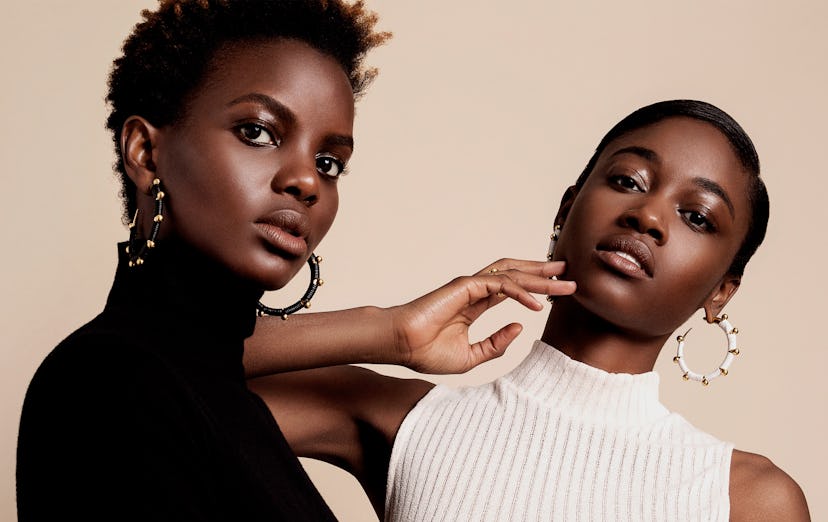Meet the 21-Year-Old Jewelry Designer Inspired by the African Diaspora
KHIRY jewelry designer Jameel Mohammed is managing school, work and an emerging luxury brand from his dorm room.

In September, the jewelry designer Jameel Mohammed showed his spring/summer 2017 collection at New York Fashion Week, when his Afro-futuristic line KHIRY was picked up by Moda Operandi. It would have been cause to celebrate under any circumstance, but Mohammed is a 21-year-old senior at the University of Pennsylvania, where he studies Political Science.
“It’s incredible to see this thing that I started begin to grow and expand onto new platforms,” he says.
In fact, the jump from Poli-Sci major to jeweler isn’t as fraught as it may seem. Inspired by the African Diaspora, he views luxury fashion as a means to explore different cultures—though he’s careful to draw distinctions between celebration and appropriation when paying homage. “I try to be really respectful of the cultures I draw inspiration from, so I do a lot of research into the cultural practices and their significance within the community to make sure I depict things in a way that’s consistent with their origins,” says Mohammed.
KHIRY Jewelry
His first piece for KIHRY, which he launched in March 2016, was called the Khatroum Bangle, and was a replica of sorts of the tapered horn of the cattle herded by the Dinka people of Sudan. “The Dinka are nomadic and the cattle plays a really central role in the tribe’s life. The shape was so strong and alluring, and I wanted to honor that by creating a piece that would be similarly central to KHIRY’s identity,” he says.
Mohammed grew up in Chicago, with parents that encouraged his understanding and appreciation of his African ancestral history through West African dance classes, Black History Month and Juneteenth celebrations, and Afro-centric books. It was all about “this is who you are and where you come from,” he recalls, and so he sought out a way to pay homage to his early childhood learnings, as well as articulate a vision for black luxury.
“I think fashion needs an alternative to the narrow definition of luxury that we’ve been presented with for so long,” he says. “And personally, it’s a means of reexamining my own history and culture, and finding beauty within myself and my people.” His references include Malick Sidibe photography, the sweeping architecture of the Great Mosque at Mecca and Alvin Ailey’s dance choreography. “I think it’s those shared cultural connections that inform that sense of kinship throughout the diaspora, and a big part of my own vision is about uncovering what those connections are and placing them on a pedestal,” he says.
KHIRY Jewelry
Mohammed first dreamt up the concept for KHIRY when he was 16. He was already a talented drawer and he taught himself fashion sketching, further developing those skills during high school internships with fashion houses Nicole Miller and Narciso Rodriquez. “I started jewelry the same way; sketching intensively, and teaching myself the production process,” he says. To get KHIRY off the ground, he launched a Kickstarter campaign, raising $20,000 in just 48 hours. After debuting the first collection this spring, Moda Opernadi and the KHIRY.com e-commerce site will be the first points of sale.
The jewelry itself is bold and expressive. “I want the pieces to be what someone turns to when they want to make a statement, and be noticed, in a chic and refined way,” he says. He uses gold vermeil and sterling silver with rhodium plating, which gives each piece that luxury esthetic found in fine jewelry. Thus far, his Adisa Drop Earrings ($425 – $495) and Khartoum Bangle Nude ($425) have been best received by consumers.
KHIRY jewelry designer Jameel Mohammed.
“Jewelry is a manageable way to push myself as a designer while still in school,” he says, though he plans to eventually expand to apparel, shoes, and maybe even furniture. As such, Mohammed looks to fashion designers such as Kerby Jean Raymond and Grace Wales Bonner for motivation. “Their ability to inject a slight political edge in their clothes and presentations” is what he admires most. It’s also what has encouraged him to ideate and produce concepts for KHIRY that others may view as controversial.
“I think the controversy really engenders within me a need to do this kind of work. Now that I’m confronted with political turmoil in the news and on the street, I can’t help but reflect that in my work,” he says. “It’s my own way of participating in the contemporary political conversation around race in America today.”